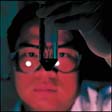 From
big lizards to astrocytomas When cells are shrunken, the sodium-proton exchanger is activated. It mediates cell uptake of sodium and water until normal cell volume is restored. At that point, it turns off. But cell volume isn't the only way this mechanism is activated. Increased hydrogen ion concentration inside the cell stimulates this enzyme, which brings salt (sodium) and water into the cell as it removes hydrogen ions. Consequently, the sodium proton exchanger also regulates cell pH. In 1980, Cala's lab was the first to identify this mechanism in living cells, specifically the red blood cells of a large Louisiana salamander known as amphiuma. Using microelectrodes, the team was able to monitor electrical activity during volume regulatory sodium uptake in individual red blood cells (each one about 35 times larger than a human red blood cell). Cala discovered that the entry of positively charged sodium ions did not change electrical activity. This finding, he recalls, was counter to everything scientists thought they knew about sodium ion movement across biological membranes. Cala concluded that this electrically-neutral sodium transport was the result of the sodium-proton exchanger.
Home |
Table of Contents |
To our Readers |
Building on Basics UC Davis Health System | © 2000, 2001, 2002 UC Regents. All rights reserved. |
  |
